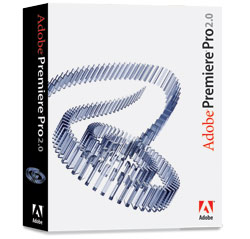Adobe Premiere Pro 2

Video editor sports many new features
 When people ask me editing questions, I always hope they’ll ask about aesthetics: “When should you cut away from a close up?” “At what point should you start the music?” “Which would be better here, a cut or a dissolve?” But inevitably, they ask, “Which is the best editing application, Final Cut, Avid, or Premiere Pro?” I’ve always hated this question. It’s worse than, “Which is better, Macs or PCs?” Who cares? What’s important is that you get the job done. The editor’s job is to tell a story, and you can do that in any nonlinear editing (NLE) software. But with the release of Adobe Premiere Pro 2, I’m rethinking my “who cares” response.
When people ask me editing questions, I always hope they’ll ask about aesthetics: “When should you cut away from a close up?” “At what point should you start the music?” “Which would be better here, a cut or a dissolve?” But inevitably, they ask, “Which is the best editing application, Final Cut, Avid, or Premiere Pro?” I’ve always hated this question. It’s worse than, “Which is better, Macs or PCs?” Who cares? What’s important is that you get the job done. The editor’s job is to tell a story, and you can do that in any nonlinear editing (NLE) software. But with the release of Adobe Premiere Pro 2, I’m rethinking my “who cares” response.
Do you use After Effects 7? If you answered “yes,” take a close look at Premiere Pro 2. You can cut a great video in any NLE, but Premiere is the only one that truly integrates with After Effects (AE). In fact, it integrates so well that once I’ve opened both programs, I sometimes forget which one I’m working in. They seem like one big program.
Premiere collides with AE in several ways. They share many of the same effects, for example: If you want to apply a lens flare, you don’t have to start up AE; you can copy-and-paste tracks from one application to the other; and, using the new Dynamic Link technology, you can edit an entire AE Comp in Premiere without having to render it first. This is huge!
Premiere Pro 2 also sports the same snazzy interface as AE 7: enlarge one palette and the others shrink to make room for it; shrink one and the others grow. As with the many other Adobe programs, Premiere now hooks into Bridge, so you can easily find and preview footage on your hard drive before importing it. Premiere also integrates well with Photoshop and Illustrator (you can import layered documents), DVD Studio Pro, and Audition (although Premiere’s internal sound-editing capabilities are very strong).
In case you haven’t heard the news, Adobe recently acquired Macromedia. So you shouldn’t be surprised to discover that Premiere can export in the Flash format, which is terrific if you want to put video on a website. By the way, you can export Flash movies from After Effects and Illustrator, too. (You can import Flash files into After Effects and Premiere.)
What else is new in Premiere Pro 2? How about HD support? Premiere can capture, edit, and output both HDV and uncompressed HD (through an HD-enabled SDI card). It can also capture standard-definition video through an SD-SDI card, and it can control VTRs via RS-422 or RS-232 connections. Also new is support for 2K and 4K resolutions and Digital Cinema export.
If you’re editing a sitcom or a football game, then you’ll flip over Premiere’s multicam editing. You can play up to four videos at once and switch between them, just as if you were editing a live show.
Want more? How about a bunch of VST effects for pro-level audio editing? And there’s subclips, which allow you to divide a captured clip into smaller clips and apply different effects to each one. Other highlights include Photoshop’s Lighting Effects filter, easy DVD authoring, export as PDF with embedded video, a Timeline that scrolls as you play, and support for Direct3D 9.0 graphics cards, which speed up previews and effects.
If you’re new to Premiere, you’ll enjoy its older features, such as the ability to measure time in both frames and audio-sample units; its AE-like keyframe animation; its full-featured titler; and its easy-to-use trimming tools.
Which is the best NLE application? I’m not telling.—Marcus Geduld
PRICE $849
FROM Adobe Systems Incorporated
PHONE 888-724-4508
WEB www.adobe.com
FOR Windows
LAYERS VERDICT
HOT HD support; multicam editing; AE integration
NOT
RATING 5
